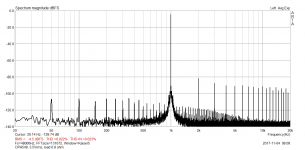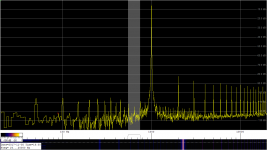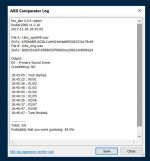And again.
Code:
foo_abx 2.0.4 report
foobar2000 v1.3.16
2017-11-05 14:50:21
File A: 1khz_549.wav
SHA1: fb97a16900ced6548fa0773a310e70bf056f9d87
File B: 1khz_gen.wav
SHA1: ae1954bae888e3af13dce14654cd318bef230f30
Output:
DS : Primary Sound Driver
Crossfading: NO
14:50:21 : Test started.
14:50:32 : 01/01
14:50:42 : 02/02
14:50:57 : 03/03
14:51:06 : 04/04
14:51:14 : 05/05
14:51:23 : 06/06
14:51:34 : 07/07
14:51:42 : 08/08
14:51:42 : Test finished.
----------
Total: 8/8
Probability that you were guessing: 0.4%
-- signature --
c44626ce7f529d09d3446e4d013ed6d4007f14abMooly
Can you use the Lacinato ABX and verify if it is still easier to differentiate.
ABX audio testing tool
Can you use the Lacinato ABX and verify if it is still easier to differentiate.
ABX audio testing tool
Code:
foo_abx 2.0.4 report
foobar2000 v1.3.16
2017-11-05 15:13:00
File A: 1khz_549.wav
SHA1: fb97a16900ced6548fa0773a310e70bf056f9d87
File B: 1khz_gen.wav
SHA1: ae1954bae888e3af13dce14654cd318bef230f30
Output:
DS : Primary Sound Driver
Crossfading: NO
15:13:00 : Test started.
15:13:43 : 01/01
15:14:02 : 02/02
15:14:15 : 03/03
15:14:35 : 04/04
15:14:48 : 05/05
15:15:01 : 06/06
15:15:10 : 07/07
15:15:19 : 08/08
15:15:28 : 09/09
15:15:37 : 10/10
15:15:48 : 11/11
15:15:58 : 12/12
15:16:07 : 13/13
15:16:15 : 14/14
15:16:30 : 15/15
15:16:42 : 16/16
15:16:42 : Test finished.
----------
Total: 16/16
Probability that you were guessing: 0.0%
-- signature --
86523eac9db3a80e6f4564133540074da8fc035cGreat results, guys, congratulations! So now it is time to find an agreement on a new test music file.
Last edited:
Can I make a comment on the files, and how I'm able to tell them apart ?
Sure, I will be glad if you do so!
Pavel,
I think that your test files are too challenging for me. The first harmonic at 2khz of your
second example is down by 75 dB and i am pretty shure is masked by the strong
1khz fundamental (the mp3 effect).
The 2nd harmonic is down by 83 dB.
I have no special treated hearing room, and i assume that the dynamic range here is no more than 80 dB.
My conclusion is that you need special test rooms and test procedures to distinguish such low distortion levels repeatable. Maybe there are hidden features which
may help to distinguish the files (like little artefacts during switch-on/off).
What do you want to show? The limits of hearing are well established...
Best,
Udo
I think that your test files are too challenging for me. The first harmonic at 2khz of your
second example is down by 75 dB and i am pretty shure is masked by the strong
1khz fundamental (the mp3 effect).
The 2nd harmonic is down by 83 dB.
I have no special treated hearing room, and i assume that the dynamic range here is no more than 80 dB.
My conclusion is that you need special test rooms and test procedures to distinguish such low distortion levels repeatable. Maybe there are hidden features which
may help to distinguish the files (like little artefacts during switch-on/off).
What do you want to show? The limits of hearing are well established...
Best,
Udo
I have been listening on headphones, which eliminates any problems with the listening room, and cuts down on external noise. But the main thing is experience; if you have spent many years listening to amplifiers, you learn to quickly pick out certain types of distortion that most people would never notice....My conclusion is that you need special test rooms and test procedures to distinguish such low distortion levels repeatable...
Maybe there are hidden features which
may help to distinguish the files (like little artefacts during switch-on/off).
What do you want to show? The limits of hearing are well established...
Best,
Udo
Udo,
very often we hear about audibility of crossover distortion (without any specification of level of harmonics) or about the 'harmful 7th harmonic' even if it is 100dB below the basic harmonic. I want to show that we need to take into account quite complex view before we start with conclusions about amplifiers. Second, I am not sure that limits of hearing of non-linear distortion are well described in their complexity.
Attached please see several plots from the amplifier under test. I am sure it would be described as too bad. I was doing the same mistake in evaluation of the distortion plots some time ago.
Attachments
What is the problem with the 7th harmonic? Is it that we are conditioned against it due to familiarity with the equal tempered scale?
Sure, I will be glad if you do so!
Well... and this is going to sound nutz 😀 but I detect a drop in pitch from one to the other. Could it be that because the files are not phase aligned, that the changeover gives that effect ?
If you play both files together there is a wah wah effect but that stays constant and doesn't seem to drift.
Maybe the D/A and the A/D are not synced to the same clock? That might account for a pitch shift.
Wha effect is usually due to rapid phase shift with respect to frequency.
Wha effect is usually due to rapid phase shift with respect to frequency.
Last edited:
Mooly
Can you use the Lacinato ABX and verify if it is still easier to differentiate.
ABX audio testing tool
Thanks Maty but I'm reasonably happy with Foobar and it seems to work OK.
I've sussed the log thing out (duh) 😀 it seems you have to paste the whole doodah onto the page, I was just doing the final signature number.
Just tried again on laptop speakers and again I hear the drop in pitch from one to the other. Again a perfect result.
Code:
foo_abx 2.0.4 report
foobar2000 v1.3.16
2017-11-05 17:44:03
File A: 1khz_549.wav
SHA1: fb97a16900ced6548fa0773a310e70bf056f9d87
File B: 1khz_gen.wav
SHA1: ae1954bae888e3af13dce14654cd318bef230f30
Output:
DS : Primary Sound Driver
Crossfading: NO
17:44:03 : Test started.
17:44:13 : 01/01
17:44:21 : 02/02
17:44:31 : 03/03
17:44:41 : 04/04
17:44:49 : 05/05
17:45:00 : 06/06
17:45:10 : 07/07
17:45:32 : 08/08
17:45:32 : Test finished.
----------
Total: 8/8
Probability that you were guessing: 0.4%
-- signature --
30a451d6ad993a6e5305197c8cbf4168f3bc7190I'm going to try and align the files in Audacity and try again.
Well... and this is going to sound nutz 😀 but I detect a drop in pitch from one to the other. Could it be that because the files are not phase aligned, that the changeover gives that effect ?
If you play both files together there is a wah wah effect but that stays constant and doesn't seem to drift.
Oh, I see, my bad ....
Because the input for 1khz_549 was generated by analog generator and is not exactly 1000Hz. The second file is digital 1kHz. So no distortion difference, but pitch difference ...
I will immediately prepare new and synchronous files!
Mooly
In my system, only with SACD ISO the foobar2000 sound better than JRiver Media Center 23, much better. But the merit is of the component Super Audio CD Decoder. With Direct (64fp, 30kHz lowpass).
Super Audio CD Decoder download | SourceForge.net
PS: all my tests were made with my cheap tweaked KEF Q100 coaxial speakers.
In my system, only with SACD ISO the foobar2000 sound better than JRiver Media Center 23, much better. But the merit is of the component Super Audio CD Decoder. With Direct (64fp, 30kHz lowpass).
Super Audio CD Decoder download | SourceForge.net
PS: all my tests were made with my cheap tweaked KEF Q100 coaxial speakers.
Last edited:
Oh, I see, my bad ....
Because the input for 1khz_549 was generated by analog generator and is not exactly 1000Hz. The second file is digital 1kHz. So no distortion difference, but pitch difference ...
I will immediately prepare new and synchronous files!
Oh heck 😀 sorry about that Pavel. I guess it shows I have good pitch discrimination if nothing else 🙂
Anyone else notice the effect ?
I deeply apologize guys. Would you mind testing again?
http://pmacura.cz/1khz_549new.zip
the previous test was invalid, sorry again. The new files are synchronous and time aligned. They come from the same source generator and are made simultaneously.
Karl and others, perfect pitch discrimination, as you know, linear changes are much more audible than nonlinear changes.
http://pmacura.cz/1khz_549new.zip
the previous test was invalid, sorry again. The new files are synchronous and time aligned. They come from the same source generator and are made simultaneously.
Karl and others, perfect pitch discrimination, as you know, linear changes are much more audible than nonlinear changes.
- Status
- Not open for further replies.
- Home
- General Interest
- Everything Else
- Test your ears in my new ABX test




